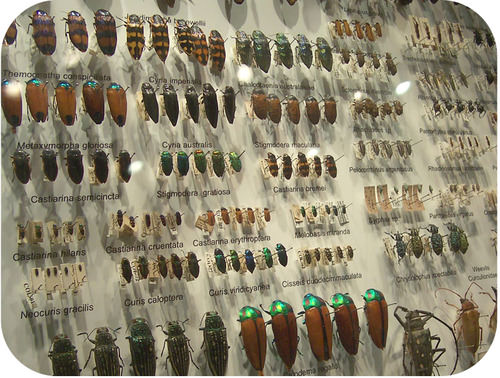Learning Outcomes
- Identify how and why scientists classify the organisms on earth

Figure 1. Only a few of the more than one million known species of insects are represented in this beetle collection. Beetles are a major subgroup of insects. They make up about 40 percent of all insect species and about 25 percent of all known species of organisms.
Why do biologists classify organisms? The major reason is to make sense of the incredible diversity of life on Earth. Scientists have identified millions of different species of organisms. Among animals, the most diverse group of organisms is the insects. More than one million different species of insects have already been described. An estimated nine million insect species have yet to be identified. A tiny fraction of insect species is shown in the beetle collection in Figure 1.
As diverse as insects are, there may be even more species of bacteria, another major group of organisms. Clearly, there is a need to organize the tremendous diversity of life. Classification allows scientists to organize and better understand the basic similarities and differences among organisms. This knowledge is necessary to understand the present diversity and the past evolutionary history of life on Earth.
Phylogenetic Trees
Scientists use a tool called a phylogenetic tree to show the evolutionary pathways and connections among organisms. A phylogenetic tree is a diagram used to reflect evolutionary relationships among organisms or groups of organisms. Scientists consider phylogenetic trees to be a hypothesis of the evolutionary past since one cannot go back to confirm the proposed relationships. In other words, a “tree of life” can be constructed to illustrate when different organisms evolved and to show the relationships among different organisms (Figure 1).
Each group of organisms went through its own evolutionary journey, called its phylogeny. Each organism shares relatedness with others, and based on morphologic and genetic evidence, scientists attempt to map the evolutionary pathways of all life on Earth. Many scientists build phylogenetic trees to illustrate evolutionary relationships.
Try It
Candela Citations
- 14.1: Form and Function. Provided by: CK-12. Located at: http://www.ck12.org/book/CK-12-Biology-I-Honors-CA-DTI3/section/14.1/. License: CC BY-NC: Attribution-NonCommercial
- Biology 2e. Provided by: OpenStax. Located at: http://cnx.org/contents/185cbf87-c72e-48f5-b51e-f14f21b5eabd@10.8. License: CC BY: Attribution. License Terms: Access for free at https://openstax.org/books/biology-2e/pages/1-introduction
